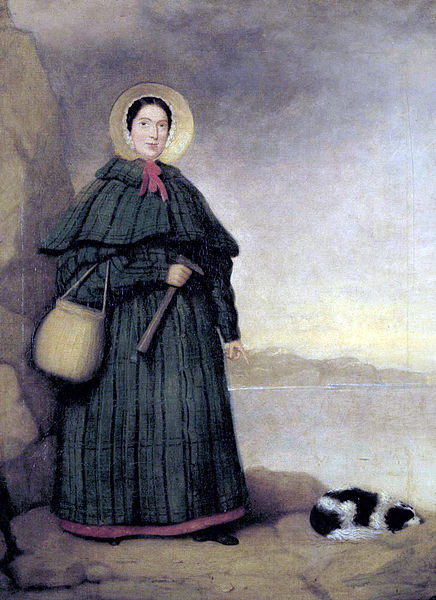Mary Anning and the Fire from Heaven January 4, 2011
Author: Beach Combing | in : Modern , trackbackBeachcombing is in disgrace tonight for accidentally sitting on ten-day-old Tiny Miss B – she was wrapped in a duvet on a sofa and Beachcombing homes in on comfort wherever it is to be found.
Beachcombing will expiate his guilt by writing about Mary Anning (obit 1847), the fossil hunter and an extraordinary fire-from-the-heavens episode in her childhood that proved almost as dangerous as Beachcombing’s posterior.
Mary Anning, for those who don’t know, is one of those petticoated heroes who get various professors of gender studies vibrating in their cathedra: ‘the greatest geologist of the nineteenth century’ etc, ‘victim of the patriarchy’ etc etc.
In truth, she was not so much a geologist as a gifted collector (‘a fossilist’) with a real scientific thirst at a time when Britain’s institutions were not capable of sating the curiosity of girls, especially those born into poverty. MA came from an artisan background and took to the cliffs and ragged slopes of Lyme Regis, her hometown, to retrieve anything fossilised that she could sell on to the middle class geologists, who swarmed to the southern coast in the nineteenth century.
If she had been born only thirty years later her sex and social class would not have been anything like as great an obstacle. She would have been trained up by a generous late Victorian scientific community and would perhaps have published scientific works in her own right.
As it is she stands uneasily between the dark days of the ‘enlightened’ eighteenth century and the brilliant light of late Victorian England. Her local community clearly saw her as half witch, half celebrity, with the strange gift of getting sovereigns for ‘dragon bones’.
Anyway back to the fire from the heavens…
When Mary was (pp. 5-6) 15 months old, August 19, 1800, she was taken to an equestrian show and there experienced something almost as deadly as a hundred kilograms of Beachcombing. A bolt of lightning struck the tree under which she was being sheltered and the girl who was holding her, Elizabeth Haskins, and two others standing besides EH were killed. Baby Mary, however, was rushed home and revived with hot water.
Her family ever afterwards believed that it was this experience that had awoken a lively intelligence in the little girl and that a sickly child from a sickly house – all but one of her several siblings died before puberty – became a healthy and strong infant thanks to the lightning blast.
Beachcombing has alluded above to the way that MA was something of a legend at Lyme: who would not be impressed by that strange woman who walked alone along the cliffs and, yet, corresponded with the most important scientists of her day including William Buckland (another post another day)? Is this story – Beachcombing must ask – not then legend: projected back by a community trying to make sense of their most bizarre yet most celebrated member?
It seems – though Beachcombing’s source here is inadequate – that the lightning blast really did take place: there are certainly circumstantial details. Whether, of course, little Mary became healthier or more intelligent as a result of that blast is another question altogether and there family and town may have indulged in some understandable myth-making. Perhaps in fifty years time the good villagers of Little Snoring will be saying of Tiny Miss B: ‘She always had such a vacant look before her father sat on her…’
There must be other examples of infant traumas being credited with transforming individuals: Beachcombing remembers George ‘Lavengro’ Borrows (obit 1881) eating magical berries in his early years, for example, and various stories about serial killers and infant head traumas. Any cases of children being transformed by lightning or other exotica drbeachcombing AT yahoo DOT com
Beachcombing wants to thank Amanda Peters for putting him on to this childhood mirabilia story.
***
24 Feb 2010: Chris writes in with a Daily Mail story: ‘A blast of electricity to the brain could provide a flash of inspiration when under pressure. Scientists have shown that zapping the grey matter with a gentle electrical current helps us discard our preconceptions and think outside the box. Donning such a ‘thinking cap’ could help us solve infuriating problems from balancing budgets at work to cracking the final crossword clue. Researcher Allan Snyder said the controversial technique could help distract us from the humdrum and unlock our inner potential, ‘seeing the world anew’. Professor Snyder, a fellow of the Royal Society, Britain’s most prestigious scientific body, was inspired by the finding that some types of brain damage can change people’s mindset and make them more open to new ideas. This led him to believe that fleetingly exciting parts of the brain key to inspiration could help people solve complex problems. To check his theory, the Australian researcher recruited 60 university students happy to have a gentle electrical current passed through their brain in the name of science….’ Beachcombing for his medical sins is sometimes electrocuted – think sitting on a cattle fence for an hour – and it definitely does something. Thanks Chris!



